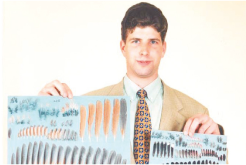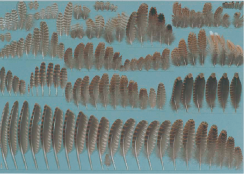







Introduction
|
Feather identification is of crucial importance to the investigation of aircraft accidents (e.g. BENTZ 1982, BENTZ & BROM 1990, BROM & BENTZ
1991). In order to evaluate and prevent the severe hazards birds can cause to aviation it is important to know what bird species are involved. After a bird strike often the only parts of the bird that remain are a few feathers or feather fragments. The identification of such remains has two approaches: - The microscopic approach involves the analysis of downy feather structures under the microscope and in some cases biochemical examination or even DNA extraction. This method is necessary if only small feather fragments or blood traces are found, but it is rather expensive as it requires special equipment and training. - In contrast, the macroscopic approach has the advantage that it relies on direct visual comparison and does not require expensive instruments. This method is useful if bigger feather remains (or other body parts) are found. |


|
|
Whereas there are already some elaborate identification keys to microscopic
feather analysis of European birds (BROM 1991, PRAST & SHAMOUN 1997), literature on macroscopic feather identification is scarce and a lacks a completely illustrated guide, especially one with color photos.
The guide to pellets and pluckings by MÄRZ (1969, revised edition reprinted
1987) contains hardly any images and its very short texts do not
provide sufficient details for identification. The series by HANSEN et al. (1973-1998) is limited to the tail feathers of central European bird species and contains only black and white drawings. The popular guide by BROWN et
al. (1987) covers less than half of the European species and only illustrates
3 or 4 feathers per species with drawings. The promising work of BUSCHING
(1991), which was planned in 10 volumes over 20 years, was unfortunately
stopped by the publisher.
Faced with this lack of a practical guide, one and a half years ago I decided to develop a feather identification book based on color photos. The project is already well advanced. Several publishers have expressed interest to print the book, but additional finances need to be acquired because of the high production cost. |
|
 English
English Deutsch
Deutsch Français
Français Italiano
Italiano 日本語
日本語 Español
Español Português
Português Russian
Russian Chinese (Simp.)
Chinese (Simp.) Czech
Czech Polish (Store only)
Polish (Store only)



